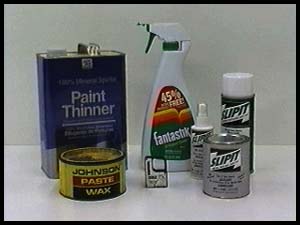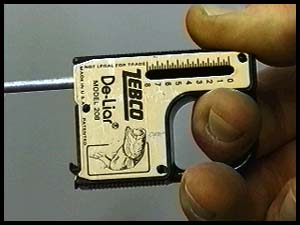

SlipIt - a tool review by Jim Mattson
Perhaps I'm not the best person to review
Slipit. For all the touted uses of it's lubricating properties,
I personally couldn't test for all of them. My windows are casement
and swing open with ease. If I had sticky drawers, I'd never
admit it, at least not to a bunch of woodworkers. I guess what
stirred my interest about this old, space-age material is the
claim it outperforms paste wax. I rely on paste wax to make my
shop glide smoothly. Is Slipit really better? Let's find out.

Slipit comes in three flavors: an aerosol can, a small spritzer
bottle and as a wax-like paste. Included with my samples were
several pages of thank-yous, testimonials and positive comments.
Additionally was a page describing all the great things Slipit
can do for homeowners, machinists and woodworkers. Slipit sounded
like a great product.
Additionally, Slipit is non-toxic with no perceivable smell. The wax and spritzer versions are pretty safe for anyone to use. This is good as it really sticks to your hands. The aerosol can has a propellant like most such products which require you to 'Keep out of reach of children' - I wasn't afraid...:-)
Tool And Table Surface Sealant/Lubricant
The first thing I did was spritz
a little Slipit on my tablesaw and fence. The directions asked
that I clean the saw first with a degreaser (I used mineral spirits)
and leave a thin film of Slipit (twice) to act as a lubricant
and rust protector. Just exactly what a thin film is wasn't very
obvious. When using wax for the same purpose you just goop it
on, wipe it out, let it dry and buff to a thin film which has
the same thickness no matter how much you initially apply - the
final depth is measured in molecules (I think).
With Slipit, you really aren't sure how much to leave behind. Do you buff it out like wax or leave it a little 'wet'? It doesn't harden like wax but it will give your saw the look of three coats of glossy lacquer - I liked it!
After leaving what I thought was a thin film I fired up the saw. Feeding a few scraps through the saw left me the impression that Slipit wasn't quite as slippery as a fresh coat of wax but for some reason the pushing seemed more purposeful and deliberate and maybe, more durable. I did notice where my unflat wood had contacted the saw top there were blotches of Slipit accumulating on the wood surface. Onward to the first test.
Silicone Free
Slipit contains no silicone and
is advertised to be completely compatible with all finishes.
I figured it had been adequately tested against lacquers but
I wondered how it fared with the water-based polyurethanes I
was spraying. Without sanding, I took one of the blotchy scrap
pieces and sprayed it with poly. After the coat had dried, it
was still possible to see the blotches of Slipit but it didn't
seem to affect the finish's adhesion. After two more coats with
about an hour in between, the blotches were still there even
though the finish was building nicely. Whether the Slipit was
under the finish or rising above it was impossible to tell. It
didn't seem to dissolve into the varnish.
I'm happy to say after a week or so, the blotches disappeared and the varnish looked as good as a water-based finish can. Still, if you start applying Slipit to surfaces in your shop, you might want to be careful where you set your freshly sanded parts, particularly if you're on a tight schedule.
Router Bit, Sawblade and Bearing Lubricant
I normally don't apply anything
to my cutters to prevent pitch buildup or to give me 'truer cuts'
as Slipit is supposed to do. I almost never cut pine and rarely
cherry - my favorite blades have Teflon coatings and besides,
how would I make such a test? Wood, even man-made panel materials
can be very subjective when it comes to pitch build-up and without
a stock feeder to level off feed rates for a tablesaw, keeping
any unconscious bias out of the results would be impossible.
There is one area Slipit might be useful to me - preventing glue
build-up on flush-trimming bearings when routing plastic laminate.
The next time I get a countertop to do I'll update this section
with a report.
Outperforms Paste Wax
Slipit claims it's better than paste wax. As a professional,
I have limited use for wax in the shop. My finishes never have
that deep hand-rubbed patina which only comes from hours of loving
care. Instead, wax is used to prevent work from hanging up during
machining with a side order of rust prevention. Indispensable
but that's it! Yet these wax applications are the ones Slipit
is touted to exceed.


